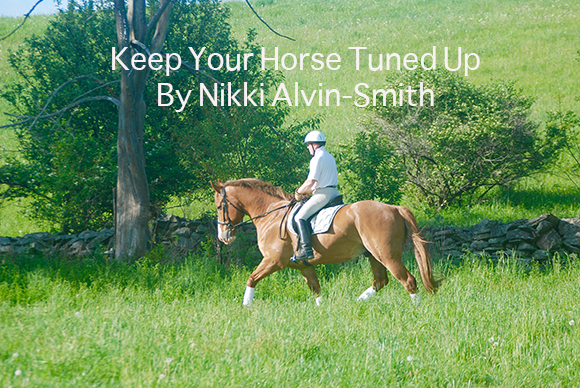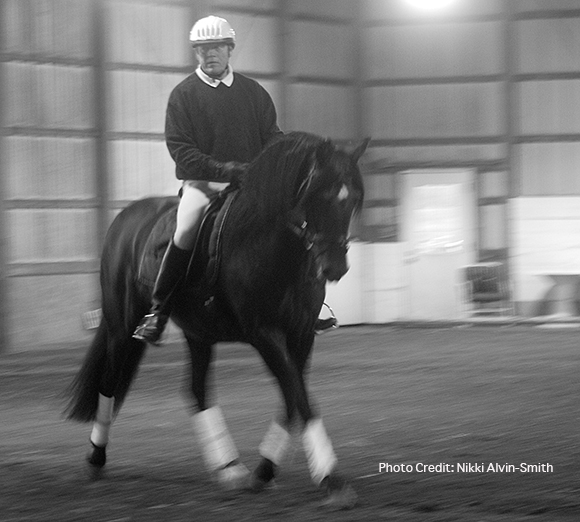Keep Your Horse Tuned Up
By Nikki Alvin-Smith

Do you find that when you ride your horse he behaves more like a donkey than a horse? When you ask him to move forward off your leg is his response immediate? No offence to donkeys but having grown up owning and riding one as a my first riding mount as a child, I can vouch that on the average day a donkey is not the most forward of creatures. This is not to say I did not become proficient in spurring him into action. Not with the use of spurs however, more by the use of ‘follow that horse’ or ‘run away from that horse.’
It was with great glee I would exchange rides on my donkey ‘Sage’, with other kids who had ponies. I would usually find them just where I left them. Trying desperately to get the donkey to move. Wise beastie that one. Meantime I would be off cantering over logs and enjoying that most beautiful of rides, the forward variety.
Eventually I had paid my dues and was given a horse. Thank goodness. The donkey lived to a ripe old age of 35 years and was always very much part of the family.
So the question is do you find your horse or pony behaves like a donkey? Is he unwilling to go forward of your leg or to transition to a faster gait. Does he generally dislike moving in a forward direction or frequently stop and misbehave by spinning, crow hopping or bucking and rearing?
If he does I commiserate because this is not a fun ride for anyone. How to solve this dilemma?
It is essential to ensure that the behavior is not caused by soreness, unsoundness or other physical ailment. No amount of work in the saddle will overcome the resistance caused by pain. Common reasons for lack of forwardness include ill-fitting tack especially the saddle or bit, physical ailments such as navicular or front end soreness and back pain. Horses that are sore in the hind end particularly the hock e.g. the young horse in training setting up the lower hock joint, will generally exhibit rushing forward and plow down in the bridle to avoid the weight on the hock. Hock and hind end issues can cause back pain over time, so a thorough medical evaluation is important. Additionally diseases such as Lyme disease and EPM can cause a horse to be lethargic and difficult to motivate, as can vitamin deficiencies such as deficiency in Vitamin B1. For the purposes of this article let’s assume your horse is wonderfully sound, healthy and the tack fits beautifully.
Now you are in the saddle and you ask the horse to move forward with a squeeze of your leg. His answer will vary between a one and a ten. The one being a slight and reluctant effort to step up and the ten being ‘don’t touch me with your leg or I’ll bolt off.’
The number one reason a horse learns not to go forward of the leg is that the rider is asking for forward movement with the leg and at the same time taking and pulling back on the rein to support their own balance. The rider may do this on either one or both reins. Most riders will tend to take a stronger hold on the left rein if they are right handed and vice versa if they are left handed. So the first ‘step’ is to be certain this is not how you are riding your horse. The push and pull effect is a go nowhere and aggravates even the most stoic horse.
When a horse is started under saddle his natural instinct is to move forward. The rider hopefully has some ground help and the horse can be led forward to start out as the rider applies a leg and voice aid and asks the horse to walk on. Somewhere down the line this communication go awry and the rider begins to hang on by the reins by a varying degree depending on how independent or not their seat has developed. The horse becomes quickly confused. His instinct is then to protest. Some horses just stop. Others offer a more dramatic response.
Any forward movement in response to the leg aid should be rewarded by removal of the leg aid. Your leg remains quietly at the horse’s side. If the horse shoots forward that is fine, simply stay with him for a few strides and then ask him to come back to you and slow down. The use of the voice is better than the use of the rein.
If you find that when you ask for an upward transition your horse is not ‘in front of your leg’ meaning does not respond immediately to your forward aid and you are certain you are not pulling him in the mouth at the same time as squeezing him with the leg aid then you should adopt the 1/2/3 rule.

Number one, squeeze lightly. No answer? Number two squeeze harder and tap the horse’s side with the heel of your boot by drawing your leg inward not upward and backward. No answer? Give the same aid as number one and tap briskly with the stick behind the inside leg aid. Be careful not to jab the horse in the mouth when using the stick or whip. You can always place the reins in one hand while you use the whip. Ensure the whip is long enough to reach behind your heel. Do not use the whip on the flank as this will encourage the horse to kick and do not use the whip on the shoulder as this is not a forward driving aid. When your horse moves forward release the leg aid and praise him.
When riding it is important not to deaden the horse to your aids. You don’t want to use your leg aid every stride. Do not be perpetually giving him the boot! Not only is this ugly it is not effective. Your horse will actually go slower and slower or he’ll protest in a more lively way by bucking. On a very rare occasion such ‘boots’, ones that belt the air out of the horse by booting at the rib may be necessary to tell them to get over themselves. If your horse needs this kind of treatment on any kind of regular basis then you should seek some professional aid in training him because obviously something has gone awry in his understanding of training.
In the same way do not half halt every stride unless it is necessary e.g. in advance of a dressage movement. A half halt is a rebalancing aid and should be used as lightly as possible and if your horse is working in harmony and good balance you should not become the ‘nag’ in the relationship.
It is also important to remember that the inside rein should always be used as lightly as possible in all gaits but especially at the canter. The inside rein (the rein that is on the inside curve of the horse no matter what his direction of travel), should move with the horse, otherwise his shoulder will be blocked and he will quickly break down to the trot or become heavy in the hand. The outside rein (the rein that is on the outside curve of the horse no matter what his direction of travel), should control the impulsion and speed. Think of your accelerator as the inside leg and the brake as the outside rein. You should never just pull on the outside rein or push continually on the inside leg. You must give and take, give and release. If you do not offer a release then you cannot reapply the aid and the aid becomes a supporting aid, which is not helpful. When you wish to slow your horse down you use the inside leg to built up the energy and the outside rein in a give and take manner releasing it just a little bit less than you take each time until the desired pace/speed/gait is reached. It is imperative that you give your horse time to answer your requests as his mind takes a little time to focus and acquiesce to your request. And these aids should be requests given without tension or holding. If you freeze then your horse will freeze and you will both be going nowhere fast or even worse going fast to nowhere you wish to visit.
Happy Riding!
About the author: Nikki Alvin-Smith is an international Grand Prix dressage trainer/clinician who has competed in Europe at the Grand Prix level earning scores of over 72%. Together with her husband Paul, who is also a Grand Prix rider, they operate a private horse breeding/training farm in Stamford, NY.


